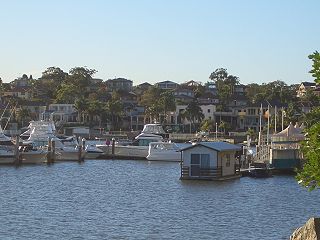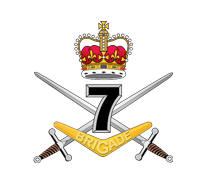
7th Brigade is a combined arms formation or brigade of the Australian Army. The brigade was first raised in 1912 as a Militia formation, although it was re-formed as part of the First Australian Imperial Force in early 1915 for service during World War I. It subsequently saw action at Gallipoli and on the Western Front during the war. Following the end of the war the brigade was disbanded in 1919 before being re-raised in 1921 as part of the Citizens Force. During World War II the brigade took part in the fighting against the Japanese in New Guinea and on Bougainville. Today, the 7th Brigade is part of Forces Command and is based in Brisbane, Queensland and is composed mainly of units of the Regular Army. While the brigade has not deployed as a whole unit since World War II, component units have deployed on operations to East Timor, the Solomon Islands, Iraq and Afghanistan.

III Corps was an Australian Army unit during World War II. It was responsible for the defence of Western Australia in 1942–1944. The corps was formed in April 1942 from Western Command, which had been established in October 1939. Throughout the war, the formation's size expanded and contracted as available manpower, and the strategic situation, dictated. At its height, the corps consisted of two infantry divisions and one armoured division, which were deployed to defend against a Japanese invasion threat, which ultimately never eventuated. The corps ceased to exist in June 1944 when it was converted back into Western Command, which remained until the end of the war in 1945.
The 3rd Army Tank Brigade was an armoured brigade of the Australian Army during the Second World War. The brigade was formed in May 1942 and disbanded in September 1943 without seeing combat.

The 16th Brigade was an infantry brigade in the Australian Army. First raised in 1912 as a Militia formation to provide training under the compulsory training scheme, the brigade was later re-raised as part of the First Australian Imperial Force during World War I. Its existence was short lived, as it was disbanded after about six months, before it could be committed to the fighting on the Western Front. Raised again in 1939 for service during World War II, the brigade was deployed to the Middle East in early 1940 and subsequently saw action in the Western Desert and in Greece in 1941. In 1942, it returned to Australia in response to Japan's entry into the war, and later the brigade played a prominent role in the Kokoda Track campaign and at Buna–Gona in Papua. Withdrawn to Australia in early 1943, the 16th Brigade was re-organised and received many replacements from disbanding formations, but it was not recommitted to combat operations until late in the war. In 1944–1945, the brigade was committed to the Aitape–Wewak campaign in New Guinea. After the war, the brigade was disbanded in 1946. Today, its name is perpetuated by the 16th Aviation Brigade which was raised on 2 April 2002.

Northern Territory Force was an Australian Army force responsible for protecting the Northern Territory during World War II. Most units assigned to the Northern Territory Force were based near Darwin and were responsible for defending the important naval and air bases in and around the town against a feared Japanese invasion. Northern Territory Force was briefly renamed the 12th Division in late 1942 but this was short-lived. Australian Army units were rotated through northern Australia during the war and six infantry brigades served as part of Northern Territory Force between 1942 and 1945. The formation was reduced over the course of the war as the strategic situation in the Pacific turned in the Allies' favour, although remnants remained until the end of the war. In early 1946, it was converted back to the 7th Military District.
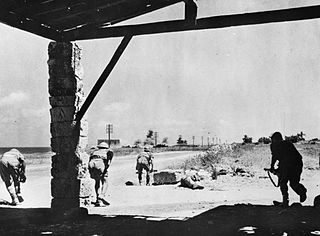
The 17th Brigade was an infantry brigade in the Australian Army. First raised in 1912 as a Militia formation to provide training under the compulsory training scheme, the brigade was later re-raised as part of the First Australian Imperial Force during World War I. Established in 1917 in the United Kingdom, it was broken up and disbanded without seeing action, and its personnel used as reinforcements for other formations. Reformed during World War II, it took part in fighting in Libya, Greece, Crete, Syria in 1941–1942. Following Japan's entry into the war, the Australian government pressed for the 6th Division's return, and the 17th Brigade was subsequently brought back from the Middle East, via Ceylon where they undertook defensive duties until July 1942. Following the brigade's return to Australia, it was deployed to New Guinea for two campaigns: the Salamaua–Lae campaign in 1943 and the Aitape–Wewak campaign in 1944–1945. After the war, the brigade was disbanded in January 1946. Today, its name is perpetuated by the 17th Sustainment Brigade, which was raised as a logistics formation in May 2006.
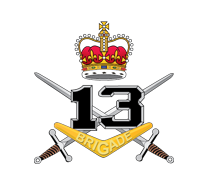
The 13th Brigade is an Army Reserve formation of the Australian Army. Originally formed in 1912 as a Militia formation in Victoria, the brigade was re-raised as a First Australian Imperial Force unit during World War I and fought on the Western Front. In the interwar years, the brigade was re-raised as a part-time formation based in Western Australia and later fought in the New Britain Campaign during World War II. It is currently headquartered at Perth in Western Australia and has units located across the state in locations such as Geraldton, Kalgoorlie, Albany, Katanning, Joondalup and Rockingham. The current brigade was formed in 1988 and is tasked with the protection of Western Australia. It forms part of the 2nd Division of the Australian Army.

8th Brigade is an Australian Army Reserve training formation. It is headquartered in Sydney, and has subordinate units in various locations around New South Wales and the rest of Australia. These units are tasked with delivering basic and initial employment training to Reserve soldiers.

The 25th Brigade was a brigade-sized infantry unit of the Australian Army that served during the Second World War. Raised in July 1940 and consisting of three infantry battalions, the 25th Brigade initially served in the United Kingdom, where it formed part of the garrison tasked with defending against a possible German invasion. In 1941, the brigade was redeployed to the Middle East where it took part in the Syria–Lebanon campaign fighting several actions around Merdjayoun and Jezzine.

The 14th Brigade was an infantry brigade of the Australian Army. Originally raised in 1912 as a Militia formation, it was later re-raised in 1916 as part of the First Australian Imperial Force for service during World War I, the brigade was assigned to the 5th Division and served on the Western Front between 1916 and 1918 before being disbanded. It was later re-raised as part of the Australia's part-time military forces during the inter-war years. During World War II, the brigade was a Militia formation and it took part briefly in the New Guinea campaign with elements of the brigade undertaking defensive duties around Port Moresby before taking part in the fighting along the Kokoda Track and around the Japanese beachheads at Buna–Gona. The brigade was disbanded in mid-1943 as part of a rationalisation of Australian military forces as a result of manpower shortages.
The 11th Division was an Australian Army unit formed during World War II by the renaming of Milne Force in December 1942. Predominately a Militia formation, the division's main role during the war was as a base command headquarters, although elements saw action in New Guinea against Japanese forces during the Finisterre Range campaign and in New Britain. It was disbanded in July 1946.

The 10th Brigade was an infantry brigade of the Australian Army. Originally formed in 1912 as a Militia formation, the brigade was re-raised in 1916 as part of the expansion of the Australian Imperial Force following the end of the Gallipoli campaign. It subsequently saw service on the Western Front in France and Belgium during the First World War. After the war it was disbanded but was re-raised in 1921 as a part-time formation based in the state of Victoria. During the Second World War the brigade was used in a garrison role in Australia before being disbanded in 1942.
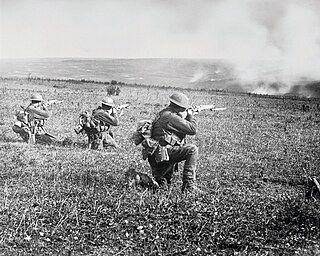
The 12th Brigade was an infantry brigade of the Australian Army. Formed in 1912 as a Militia formation, it was later re-raised in 1916 as part of the all volunteer First Australian Imperial Force that was raised for overseas service during the First World War. The brigade was part of the 4th Division and fought on the Western Front until the end of the war in November 1918. During the inter-war years, the brigade was re-formed in Australia as a part-time unit; during the Second World War, it was mobilised for full-time service, but did not serve overseas, undertaking garrison duties in Australia until 1945 when it was used to raise Timor Force.
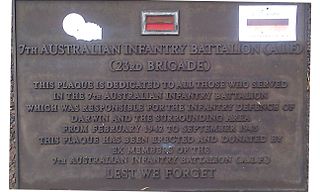
The 23rd Brigade was a brigade of the Australian Army. It was briefly raised in 1912 as a Militia formation providing training as part of the compulsory training scheme. Later, it was re-formed in July 1940 for service during the Second World War, the brigade was initially a formation of the Second Australian Imperial Force assigned to the 8th Division; however, after its sub units were captured by the Japanese in 1942 it was reformed with Militia battalions and was mainly used in a garrison role around Darwin, in the Northern Territory, until late in the war when it was committed to the fighting against the Japanese on Bougainville. It was disbanded in 1946.
The 28th Brigade was a formation of the Australian Army during World War II. Raised in April 1941, the brigade consisted of Militia units who were assigned to carry out defensive duties on the New South Wales Central Coast. After being mobilised for war in December 1941, the brigade mounted defensive duties throughout 1942 and 1943, defending against a possible Japanese invasion. As this threat passed, the brigade's role diminished throughout 1943. Eventually, the brigade was disbanded in December 1943 having never seen combat. Its constituent units either amalgamated with others, or broken up as reinforcements.

The 19th Brigade was a formation of the Australian Army that was raised as part of the Second Australian Imperial Force for service during World War II. It was briefly raised in 1912 as a Militia formation providing training as part of the compulsory training scheme. Later, during World War II, the brigade was established in April 1940 in Palestine as a triangular formation, the brigade was created by transferring one infantry battalion from three other brigades. It was subsequently assigned to the 6th Division. Throughout 1941, the brigade fought in North Africa, Greece and on Crete, before undertaking garrison duties in Syria, remaining there until January 1942. Following the Japanese entry into the war, the 19th Brigade was withdrawn to Australia and subsequently undertook garrison duties in Darwin. It did not see combat again until late in the war, when it was committed to the Aitape–Wewak campaign in 1944–1945. The brigade was disbanded in December 1945 in Puckapunyal.
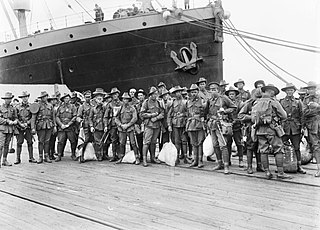
The 5th Machine Gun Battalion was an infantry support unit of the Australian Army. Originally formed in March 1918 for service during World War I as part of the all volunteer Australian Imperial Force, it was one of five such units raised as part of the AIF during the war. The battalion consisted of four machine gun companies, which had previously existed as independent companies assigned mainly at brigade level. The battalion took part in the final stages of the war, seeing action during the Allied defensive operations during the German Spring Offensive and then the Allied Hundred Days Offensive, which finally brought an end to the war. The battalion was disbanded in mid-1919 during the demobilisation of the AIF following the conclusion of hostilities. During World War II, the battalion was re-raised as part of the Militia in September 1942, and undertook garrison duties in the Torres Strait, until it was disbanded in May 1944.




